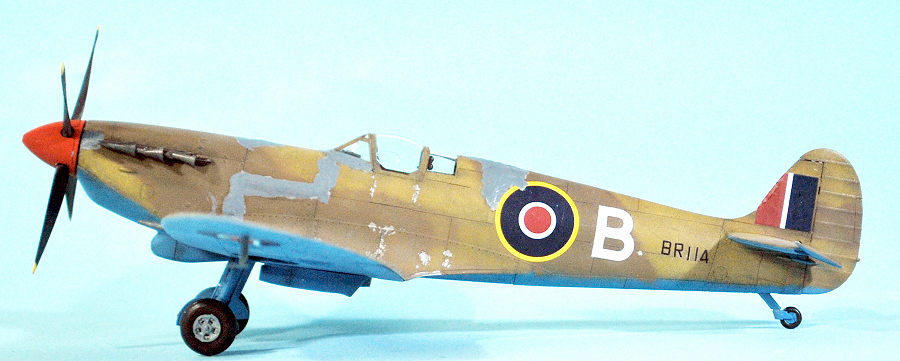
Eduard 1/48 Spitfire VI
| KIT #: | 11157 |
| PRICE: | $89.95 |
| DECALS: | Ten options |
| REVIEWER: | Tom Cleaver |
| NOTES: | Easy conversion |

| HISTORY |
The Junkers Ju-86P and R aircraft were modifications of the original Ju-86 disel-powered bomber to meet an RLM specification for an ultra-high altitude bomber and photo reconnaissance aircraft. Some 30 of the original Ju-86 airframes were modified to the new standard, with a pressurized cockpit for two, specially-aspirated and supercharged Junkers Jumo 207B-3 diesel engines, and their wingspan increased to 105 feet. The service ceiling of these aircraft was 47,000 feet, well above the maximum attainable altitude of any RAF interceptor.
Knowledge of the existence of these aircraft led the RAF to develop the Spitfire Mk. VI, the first special high-altitude Spitfire fighter. The Mk VI used the same airframe and armament as the Mk Vb, but ws powered by a special Merlin 47 engine giving 1,415 hp with a four bladed propeller. The most distinctive feature of the Mk. VI was its extended wingtips, designed to increase its performance at high altitude. The Mk VI was not a great success; the pressurized cockpit had a canopy that was locked in place from the outside, making it unpopular with the pilots. Its performance was not as impressive as had been hoped, being only able to attain about 38-39,000 feet. Between December 1941-October 1942, 97 Mk VIs were built. All but six, which were sent to the Middle East, were issued to two squadrons of RAF Fighter Command.
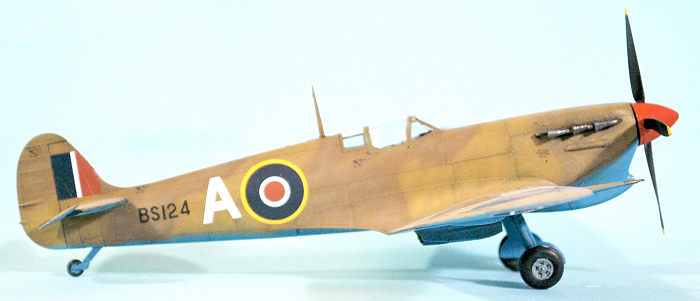 While the Ju-86
“threat” was fairly quickly met in the UK by shooting down one and damaging
another, in June 1942 four Ju-86P-2s were issued to 2.(F)/123, based at Kastelli
on Crete. From there, they were able to reach Egypt, where at first they were
still safe.
While the Ju-86
“threat” was fairly quickly met in the UK by shooting down one and damaging
another, in June 1942 four Ju-86P-2s were issued to 2.(F)/123, based at Kastelli
on Crete. From there, they were able to reach Egypt, where at first they were
still safe.
The British were hanging on by their fingernails in North Africa as they fought Rommel. They were only able to stop the Afrika Korps at El Alamein in Egypt, so close to the Suez Canal that people in Cairo could hear the sound of the artillery on the battlefield.
General Bernard Montgomery was now in command of the British Eighth Army, and he intended an offensive that would turn back the Afrika Korps. Unfortunately, the desert provided little opportunity to camouflage the massive ammunition dumps and truck and tank storage areas behind the front.
The photo-recon missions were flown along the Nile from Alexandria to Cairo, and along the Suez Canal from Port Said to Suez in August and early September 1942, and brought back photographic evidence of the huge build-up of Allied equipment and supplies, leading the Germans to the correct conclusion that Montgomery would soon be in a position to launch a major and perhaps decisive offensive in North Africa. The stratospheric spies had to be stopped.
Six Spitfire HF Mk. VI Spitfires - BS106, BS124, BS133, BS134, BS149 - that were sent out to Egypt in June proved unable to reach the Ju-86's operating altitude when they attempted interceptions in early July.
103 Maintenance Unit at Aboukir was the RAF’s biggest aircraft depot outside England. There was a highly-competent engineering staff available, which had already proven themselves superior to the engineers at Supermarine when they cane up with an aerodynamically-superior dust filter for the Spitfires that were now arriving in the Middle East. The engineers began a project to create a high altitude interceptor capable of stopping the Ju-86.
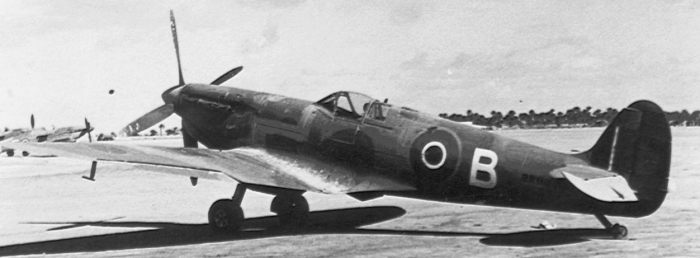 The
engineering section was given permission to modify three newly-arrived Spitfire
Vc s; these were BP985, BR114 and BR234. They were given the 4-bladed props from
three of the Mk. VI fighters to improve performance. All unnecessary equipment
was stripped out, including the standard armor, armament and radio. Locally
produced extended wingtips were fitted. Armament was reduced to one .50 caliber
machine gun in each wing. Rathern than merely overpaint the original factory
paint, the Aboukir paint shop stripped the special Spitfires to bare metal and
then gave them only a thin coat of camouflage paint as part of the battle
against weight. BP985 was passed to the Delta Defense Force. Spitfire Vc BR114,
coded "B," was the Spitfire that would finally be used.
The
engineering section was given permission to modify three newly-arrived Spitfire
Vc s; these were BP985, BR114 and BR234. They were given the 4-bladed props from
three of the Mk. VI fighters to improve performance. All unnecessary equipment
was stripped out, including the standard armor, armament and radio. Locally
produced extended wingtips were fitted. Armament was reduced to one .50 caliber
machine gun in each wing. Rathern than merely overpaint the original factory
paint, the Aboukir paint shop stripped the special Spitfires to bare metal and
then gave them only a thin coat of camouflage paint as part of the battle
against weight. BP985 was passed to the Delta Defense Force. Spitfire Vc BR114,
coded "B," was the Spitfire that would finally be used.
Because the “striker” had no radio for guidance, a “marker” was needed. Spitfire VI BS124 had its .303 caliber machine guns removed annd its IFF fear; at the altitude they would be at, there would be no other aircraft to be confused with. It was believed BS124 could likely get to 39-40,000 feet, hopefully within visual range of the Ju-86, so that the pilot of BR114 could then climb up to the enemy’s altitude and dispatch the spy.
The Spitfire Vc had no pressurization. Once it was ready to fly, putty was used to fill in any small openings in the cowling and around the cockpit to reduce depressurization as much as possible. The pilot was in danger of passing out at the decisive moment, since the pressurized oxygen system could not deliver sufficient oxygen above 40,000 feet.
The Spitfires were flown by Test Pilots from 103MU Special Duties Flight at Aboukir.
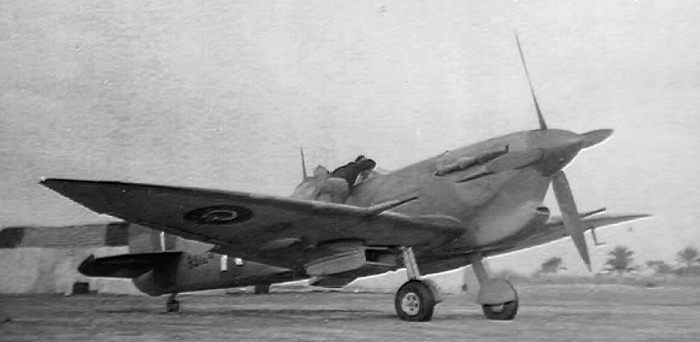 The first
successful interception was flown on August 24,1942, when Flying officer A.
Reynolds claimed a Ju-86P destroyed. On August 29, the “Marker” Spitfire was
able to get to 41,000 feet, from where the Ju-86P was clearly visible at the
head of its streaming exhaust at 49,000 feet. Pilot Officer Georges Genders
managed to climb to the Ju86's altitude. Genders only fired a short burst before
the guns jammed and he stalled out and dropped to a lower altitude. He made no
claim, but the the JU86P ditched.
The first
successful interception was flown on August 24,1942, when Flying officer A.
Reynolds claimed a Ju-86P destroyed. On August 29, the “Marker” Spitfire was
able to get to 41,000 feet, from where the Ju-86P was clearly visible at the
head of its streaming exhaust at 49,000 feet. Pilot Officer Georges Genders
managed to climb to the Ju86's altitude. Genders only fired a short burst before
the guns jammed and he stalled out and dropped to a lower altitude. He made no
claim, but the the JU86P ditched.
On September 6, 1942, Genders was again in BR114. Climbing to 47,000 feet he again only fired two bursts before the guns jammed, but the Ju-96 was damaged and began descending. At 39,000 feet it was attacked by Pilot Officer Gold, who was flying the Mk. VI “marker;” he shot it down with a burst from his 20mm cannon and it crashed into the sea.
Further interceptions were made by Reynolds on September 10 and Gold on September 15. In both cases they were unable to destroy the Ju-86, but they damaged each sufficiently that the airplanes were lost over the Mediterreanean returning to their Greek base. After this, the single surviving Ju-86P was taken off operations since its sole defense of flying too high to be intercepted was gone.
When Genders made his interception at 49,000 feet, he later described as being “on the top of the world.” He was able to see Crete to the north, the Gulf of Sirte to the West, across the Sinai peninsula to the east and almost to Sudan to the South.
| THE KIT |
The Eduard limited edition “Spitfire Story: Southern Skies” includes two kits: a Spitfire Vb and a Spitfire Vc. Since it is for “tropical” aircraft, the sprue that includes both the Vokes and “Aboukir” filters is included.
| CONSTRUCTION |
 I used the
4 blade spinners from two damaged Hasegawa Spitfire IX models, replacing the
too-wide blades with correct blades cut off the Rotol props I had left over from
previous Spitfire V projects (never throw extra parts away!). I also used the
extended tips from Eduard Spitfire VIII kits, including a pair sent me by Andy
Abshier.
I used the
4 blade spinners from two damaged Hasegawa Spitfire IX models, replacing the
too-wide blades with correct blades cut off the Rotol props I had left over from
previous Spitfire V projects (never throw extra parts away!). I also used the
extended tips from Eduard Spitfire VIII kits, including a pair sent me by Andy
Abshier.
The Spitfire Vb only needed a little modification. I used the Spitfire VIII extended tips and an intake for the pressurization system on the right cowling that I made from some Evergreen plastic dowel sanded to shape. I also made the rear bulkhead for the pressurized cockpit from Evergreen sheet. I glued the side flap closed and filled in the panel lines since that feature ws removed from the Spitfire VI.
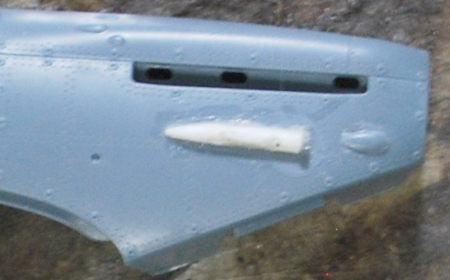 The Spitfire
Vc needed to be modified by cutting off the mounts for the cannons on the
leading edge of the wing, and using Evergreen sheet plastic to make the flat gun
covers. The extended wingtips were lightly sanded to a more pointed tip. The
Aboukir filter in the kit was used. I ran CA glue along the panel lines where
putty was used, using the photos of BR114 for reference.
The Spitfire
Vc needed to be modified by cutting off the mounts for the cannons on the
leading edge of the wing, and using Evergreen sheet plastic to make the flat gun
covers. The extended wingtips were lightly sanded to a more pointed tip. The
Aboukir filter in the kit was used. I ran CA glue along the panel lines where
putty was used, using the photos of BR114 for reference.
| COLORS & MARKINGS |
The Spitfire VI was painted at the Castle Bromwich factory in desert camouflage before being sent out.
The Spitfire Vc was painted in an Aboukir “approximation” scheme which I did from reference to the photos of BR114. The putty was painted light grey; others have interpreted it as silver, but in my experience, putty used on aircraft is grey.
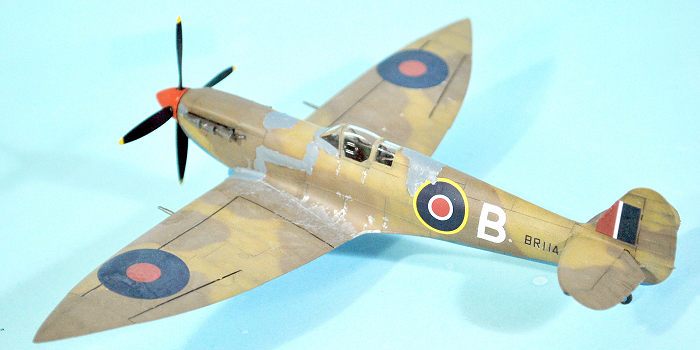 I freehanded
both using my Tamiya paint mixtures for Dark Earth, Middle Stone and Azure Blue.
I freehanded
both using my Tamiya paint mixtures for Dark Earth, Middle Stone and Azure Blue.
The Spitfire VI had full stenciling. I used the decals in the kit for the national markings and stencils.
The Spitfire Vc only had wingwalks painted on, and did not have any other stenciling. I used national markings from an Eduard sheet. The “A” and “B” decals came from sheets sourced from the decal dungeon.
The photos show these airplanes pretty clean, other than the wingwalk area on the left wing of BR114 is really scuffed down to bare metal. I think this is due to the airplane having been stripped to bare metal and repainted with a thin coat of paint to save weight.
I unmasked the canopies, attached the props, exhausts and landing gear.
| CONCLUSIONS |
I’ve never had a Spitfire VI in my collection before. These two very different Spitfires tell an interesting story. The conversions were easy and only required some additional spare parts any serious Spitfire modeler who doesn’t throw away “extra” parts will have available.
9 June 2022
Copyright ModelingMadness.com. All rights reserved. No reproduction in part or in whole without express permission.
Review Kit courtesy of my wallet.
If you would like your product reviewed fairly and fairly quickly, please contact the editor or see other details in the Note to Contributors.